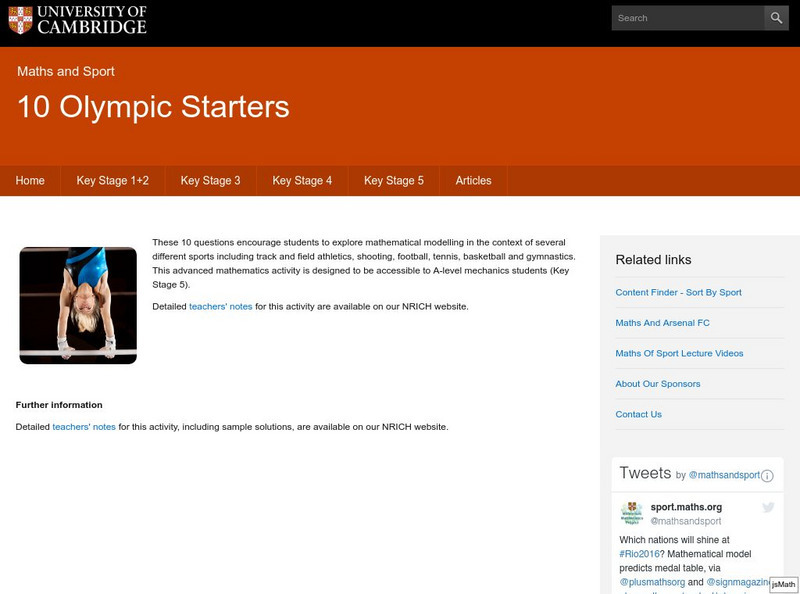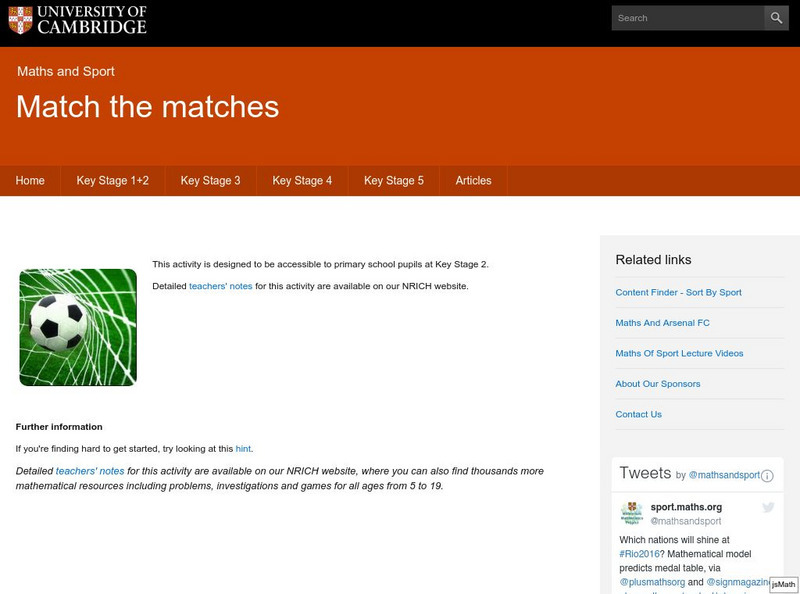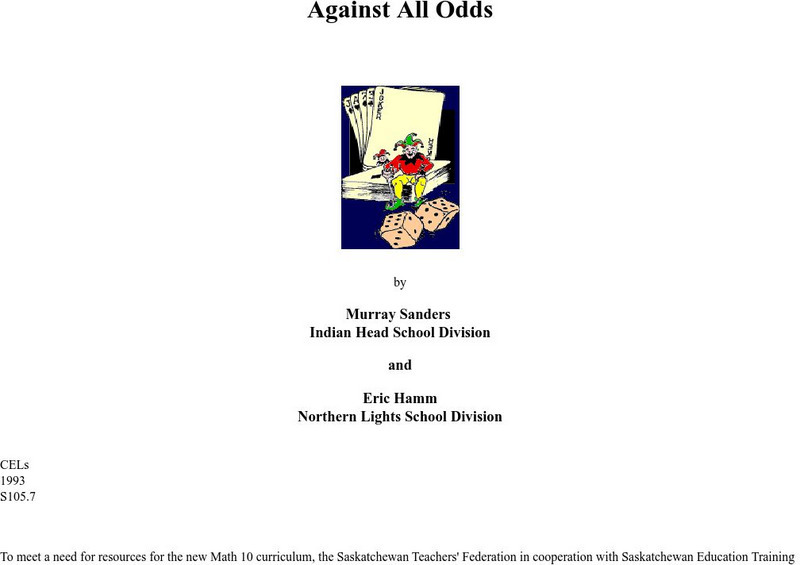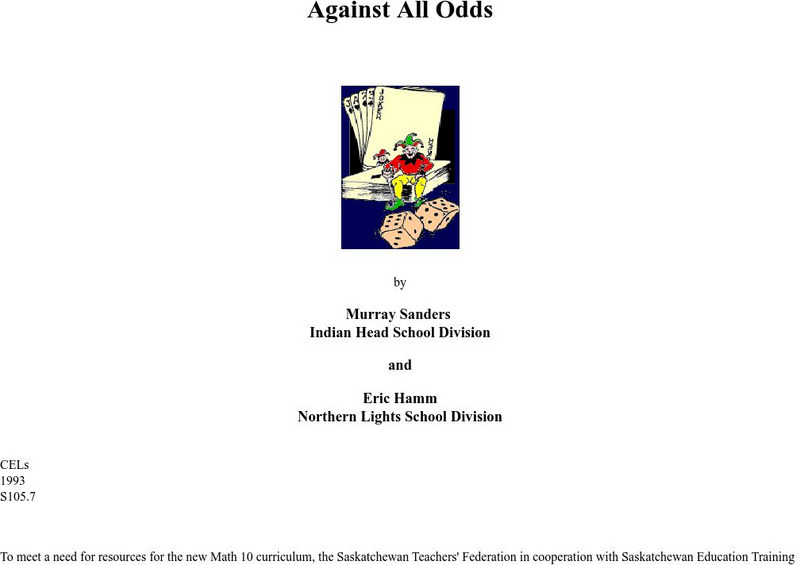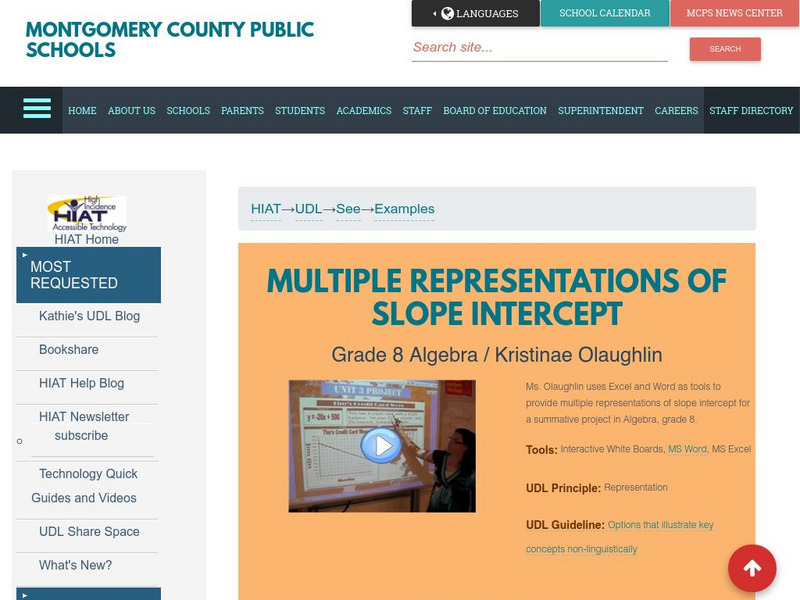Hi, what do you want to do?
University of Cambridge
University of Cambridge: Maths and Sports: Our Sports
What events are there in your school sports day, and in the Olympic Games? What are your favourite races and sports? This activity encourages discussion and decisions about how to collect and display data, and is designed to be...
University of Cambridge
University of Cambridge: Maths and Sports: Swimming Pool
We're investigating the number of steps we would climb up or down to get out of or into the swimming pool. How could you number the steps below the water? This activity uses the familiar environment of a swimming pool to introduce...
University of Cambridge
University of Cambridge: Maths and Sports: The Games' Medals
Who could have won the gold, silver and bronze medals? This activity is designed to be accessible to primary pupils at Key Stage 1.
University of Cambridge
University of Cambridge: Maths and Sports: 10 Olympic Starters
These 10 questions encourage students to explore mathematical modelling in the context of several different sports including track and field athletics, shooting, football, tennis, basketball and gymnastics. This activity is designed to...
University of Cambridge
University of Cambridge: Maths and Sports: Match the Matches
Decide which charts and graphs represent the number of goals two football teams scored in fifteen matches. This data handling activity is designed to get children talking meaningfully about mathematics, presenting and justifying...
University of Cambridge
University of Cambridge: Maths and Sports: Olympic Rings
This activity explores shapes and circles by encouraging children to look really hard at something they will see very often in the run-up to London 2012, and is designed to be accessible to primary pupils at Key Stage 1.
University of Cambridge
University of Cambridge: Maths and Sports: Olympic Starters
How do you compare to these results from Olympic Games in the past if you try similar running and jumping activities? This activity uses the history of the Olympic Games to introduce ideas about measuring time and distances in standard...
Arizona State University
Arizona State University: Symmetrical Design
Here, at this site from the Arizona State University, is a simple lesson plan for math or art teachers in the primary grades. Students create their own symmetrical design based on Pennsylvania barn signs. Also has a link to a site with...
University of Regina (Canada)
University of Regina: Math Central: Probability Activity
The unit introduces the topic of probability and then students work in groups to find the odds of winning a game they design. The students learn how to summarize financial projections and appreciate the role of probability in real world...
University of Regina (Canada)
University of Regina: Math Central: Probability Activity
The unit introduces the topic of probability and then students work in groups to find the odds of winning a game they design. The students learn how to summarize financial projections and appreciate the role of probability in real world...
University of Waterloo (Canada)
University of Waterloo: Cemc: Geometry and Spatial Sense: Transformations [Pdf]
Accompanied by links to online activities and demonstrations, middle schoolers learn about the different types of transformations on a coordinate grid through this lesson plan. The lesson is designed to match the Grade 7 Ontario...
Other
U. Of Wisconsin: Formulating Statistical Questions and Collecting Data
This slideshow gives a detailed explanation of the characteristics of statistical questions and how they differ from other types of questions, the types of studies, and the methods for collecting data. It describes the case of Clever...
Montgomery CountyPublic Schools
Mcps: Multiple Representations of Slope Intercept
A Grade 8 Math teacher describes how she uses Excel and Word as tools to provide multiple representations of slope intercept for a UDL summative project in Algebra.
University of Illinois
University of Illinois: Early Math Counts: Designing Virtual Lands!
This article describes activities to do with young children using apps where they can build structures. It discusses two possible apps to try - Toca Builder and Blokify. Links to videos that tell you more about these apps are included.
Rice University
Rice University: Cynthia Lanius: Designer Fractions Symmetry
This site takes a look at symmetry, with a special focus on line symmetry. Here you will find a definition, as well as several examples and real-world applications.
University of Georgia
University of Georgia: Inter Math: Constructionary
The activity is designed to help learners create constructions using Geometer?s Sketchpad. The geometry tutorial consists of definitions and pictures of mathematics terms.
Alabama Learning Exchange
Alex: This Is How We Roll!
Students take on the role of engineers who need to design a roller coaster. They will explore the history of roller coasters, the different types, and the many things that can affect the success or failure of a roller coaster. Finally,...
Other
Duke: Center for Inquiry Based Learning
Duke University has established the Center for Inquiry-Based Learning. It serves to enhance math and science lessons. Click on Resources for good examples of Inquiry-based lesson plans.
Alabama Learning Exchange
Alex: "Shape Up or Ship Out"
In this activity, students will identify shapes that architects use to build houses. Students will then explore these shapes by building a model "dream" home.This lesson plan was created as a result of the Girls Engaged in Math and...
CPALMS
Cpalms: Building Graduation Caps
[Free Registration/Login Required] In this lesson, students build geometric models of graduation caps using stiff paper. The activity requires the application of skills in finding surface area, understanding similarity, knowing the...
Alabama Learning Exchange
Alex: The Great Plant Escape
This is a WebQuest that is designed to introduce students to plant science. Activities enhance student's math, science, language arts, social studies, music and art. There are many options in this program. Choose any or all of the...
Alabama Learning Exchange
Alex: Battleships
This lesson is designed to review and reinforce three methods (graphing, substitution and elimination) of solving systems of linear equations. The students will work together and independently to find the solutions to systems of...
Alabama Learning Exchange
Alex: Beyond the Earth Part Ii
A continuation of Beyond the Earth Part I. As part of a unit on the solar system, young scholars will choose a component of the solar system to research. Students may use a variety of resources such as the Internet, books, and reference...
Alabama Learning Exchange
Alex: Genetic Babies
Learners will explore Gregor Mendel's laws of genetics in this lesson. Students will be paired in male and female groups. If girls and boys can't be evenly divided, same sex learners can be paired to represent research scientists....








